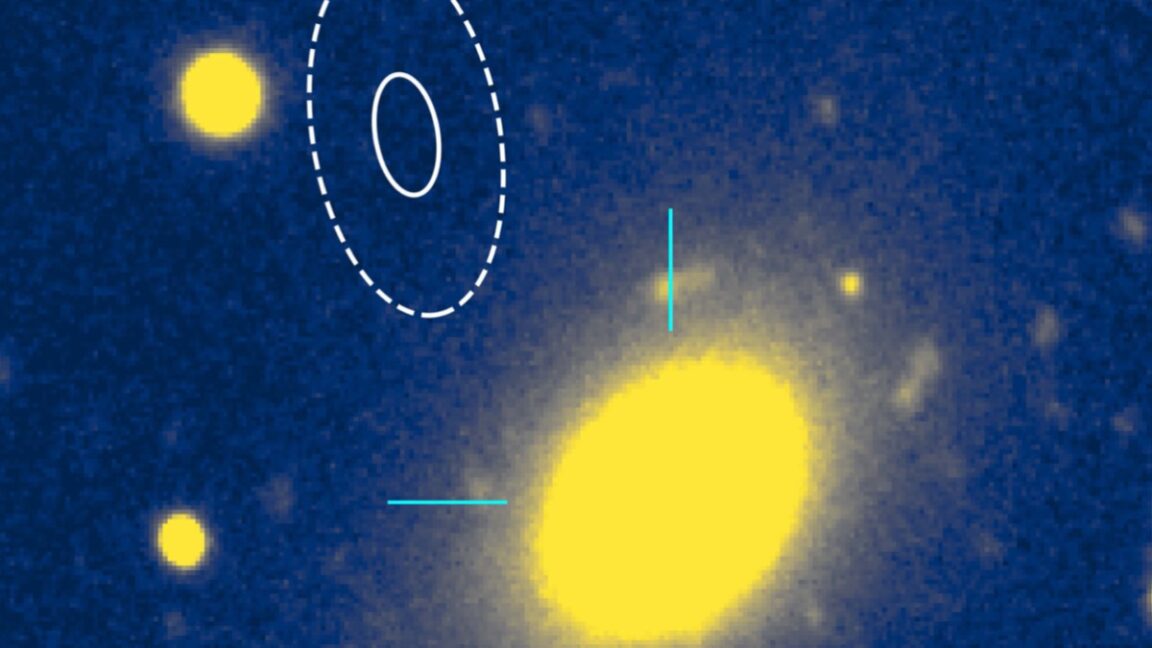
ARSTECHNICA.COM
Fast radio burst in long-dead galaxy puzzles astronomers
a fresh puzzle Fast radio burst in long-dead galaxy puzzles astronomers Result "challenges existing theories that tie FRB origins to phenomena in star-forming galaxies." Jennifer Ouellette Jan 22, 2025 1:06 pm | 5 The new ability to pinpoint sources of fast radio bursts places one recent burst in a surprising location. Credit: Gemini Observatory The new ability to pinpoint sources of fast radio bursts places one recent burst in a surprising location. Credit: Gemini Observatory Story textSizeSmallStandardLargeWidth *StandardWideLinksStandardOrange* Subscribers only Learn moreFast radio bursts (FRBs) are puzzling phenomena because their details are so difficult to resolve, and observations to date have been inconsistent. Astronomers added another piece to the puzzle with the detection of an FRB that seems to originate in a dead galaxy that is no longer producing new stars, according to a new paper published in The Astrophysical Journal Letters, along with a related paper on the event from scientists at Northwestern University.As we've reported previously, FRBs involve a sudden blast of radio-frequency radiation that lasts just a few microseconds. Astronomers have observed over a thousand of them to date; some come from sources that repeatedly emit FRBs, while others seem to burst once and go silent. You can produce this sort of sudden surge of energy by destroying something. But the existence of repeating sources suggests that at least some of them are produced by an object that survives the event. That has led to a focus on compact objects, like neutron stars and black holesespecially a class of neutron stars called magnetarsas likely sources. Only about 3 percent of FRBs are of the repeating variety.There have also been many detected FRBs that don't seem to repeat at all, suggesting that the conditions that produce them may destroy their source. That's consistent with a blitzara bizarre astronomical event caused by the sudden collapse of an overly massive neutron star. The event is driven by an earlier merger of two neutron stars; this creates an unstable intermediate neutron star, which is kept from collapsing immediately by its rapid spin.Last July, astronomers looked specifically at the properties of polarized light emitting from these FRBs, yielding further insight into the origins of the phenomenon. The analysis supported the hypothesis that there are different origins for repeating and non-repeating FRBs. And earlier this month, a rare burst provided indications that FRBs likely originate near a star and that they share a feature with the emissions of pulsars, another subtype of neutron star. That burst was also consistent with a magnetar's intense magnetic fields being the key to driving these events. However, it's still possible that more than one type of event produces something that looks like an FRB.A surprising sourceFRBs are of particular interest because they can be used as probes to study the large-scale structure of the universe. That's why Calvin Leung, a postdoc at the University of California, Berkeley, was so excited to crunch data from Canada's CHIME instrument (Canadian Hydrogen Intensity Mapping Experiment). CHIME was built for other observations but is sensitive to many of the wavelengths that make up an FRB. Unlike most radio telescopes, which focus on small points in the sky, CHIME scans a huge area, allowing it to pick out FRBs even though they almost never happen in the same place twice.Leung was able to combine data from several different telescopes to narrow down the likely position of a repeating FRB, first detected in February 2024, located in the constellation Ursa Minor. When he and his CHIME collaborators further refined the accuracy of the location by averaging many bursts from the FRB, they discovered that this FRB originated on the outskirts of a long-dead distant galaxy. That throws a wrench into the magnetar hypothesis because why would a dead galaxy in which no new stars are forming host a magnetar?It's the first time an FRB has been found in such a location, and it's also the furthest away from its galaxy. CHIME currently has two online outrigger radio arrays in placecompanion telescopes to the original CHIME radio array in British Columbia. A third array comes online this week in Northern California, and according to Leung, it should enable astronomers to pinpoint FRB sources much more accuratelyincluding this one. Data has already been incorporated from an outrigger in West Virginia, confirming the published position with a 20-times improvement in precision."This result challenges existing theories that tie FRB origins to phenomena in star-forming galaxies, said co-author Vishwangi Shah, a graduate student at McGill University. The source could be in a globular cluster, a dense region of old, dead stars outside the galaxy. If confirmed, it would make FRB 20240209A only the second FRB linked to a globular cluster.V. Shah et al., Astrophysical Journal Letters, 2025. DOI: 10.3847/2041-8213/ad9ddc (About DOIs).T. Eftekhari et al., Astrophysical Journal Letters, 2025. DOI: 10.3847/2041-8213/ad9de2 (About DOIs).Jennifer OuelletteSenior WriterJennifer OuelletteSenior Writer Jennifer is a senior writer at Ars Technica with a particular focus on where science meets culture, covering everything from physics and related interdisciplinary topics to her favorite films and TV series. Jennifer lives in Baltimore with her spouse, physicist Sean M. Carroll, and their two cats, Ariel and Caliban. 5 Comments
0 Σχόλια
0 Μοιράστηκε
141 Views


